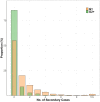Time-varying overdispersion of SARS-CoV-2 transmission during the periods when different variants of concern were circulating in Japan
- PMID: 37580339
- PMCID: PMC10425347
- DOI: 10.1038/s41598-023-38007-x
Time-varying overdispersion of SARS-CoV-2 transmission during the periods when different variants of concern were circulating in Japan
Abstract
Japan has implemented a cluster-based approach for coronavirus disease 2019 (COVID-19) from the pandemic's beginning based on the transmission heterogeneity (overdispersion) of severe acute respiratory coronavirus 2 (SARS-CoV-2). However, studies analyzing overdispersion of transmission among new variants of concerns (VOCs), especially for Omicron, were limited. Thus, we aimed to clarify how the transmission heterogeneity has changed with the emergence of VOCs (Alpha, Delta, and Omicron) using detailed contact tracing data in Yamagata Prefecture, Japan. We estimated the time-varying dispersion parameter ([Formula: see text]) by fitting a negative binomial distribution for each transmission generation. Our results showed that even after the emergence of VOCs, there was transmission heterogeneity of SARS-CoV-2, with changes in [Formula: see text] during each wave. Continuous monitoring of transmission dynamics is vital for implementing appropriate measures. However, a feasible and sustainable epidemiological analysis system should be established to make this possible.
© 2023. Springer Nature Limited.
Conflict of interest statement
The authors declare no competing interests.
Figures



References
Publication types
MeSH terms
LinkOut - more resources
Full Text Sources
Medical
Miscellaneous

